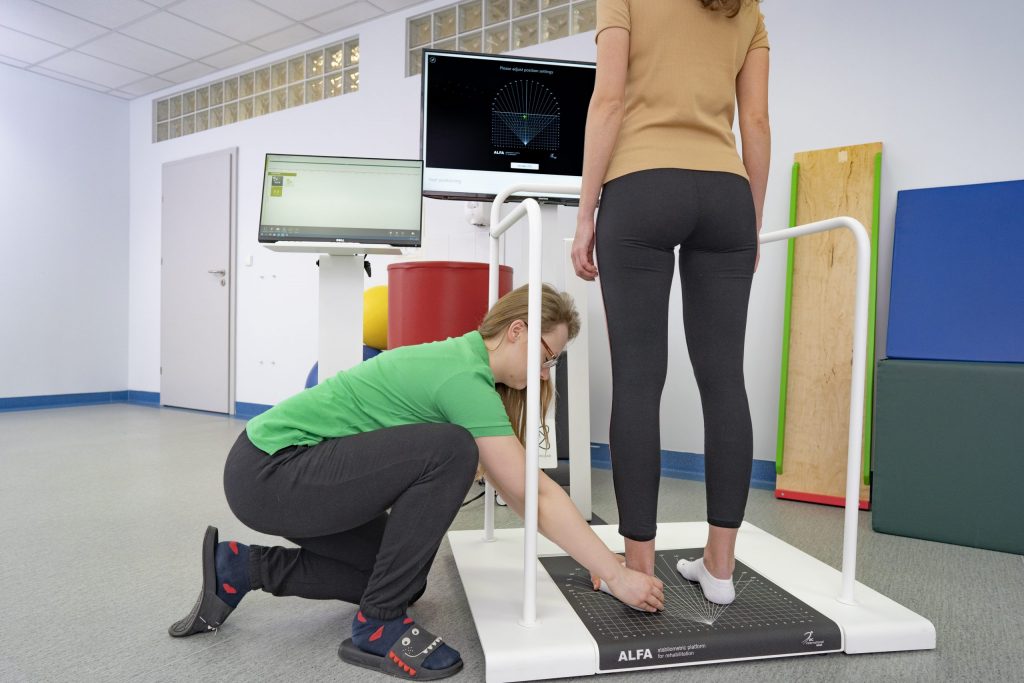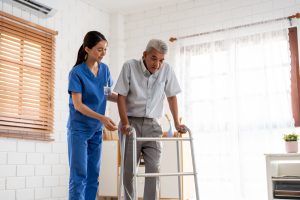
Romberg Test in Balance and Proprioception Assessments
Treatment GuidelinesDiscover how the Romberg test assesses proprioception, balance and sensory ataxia. Learn how to use advanced diagnostic tools for your balance assessments.
The Romberg test is a classic example of a simple, efficient, and functional balance assessment. It can be administered almost anywhere and gives instant feedback about a patient’s balance skills. This balance assessment can provide you with valuable insight into many different diagnoses. Evaluating your patient’s proprioceptive awareness and balance offers a glimpse into the neurological components of their stability.
What Is the Romberg Test?
A neurologist named Moritz Romberg initially developed this test in the 19th century to diagnose late-stage syphilis.1 Over time, it has become more valuable as a diagnostic tool for problems with proprioception. Proprioception is the body’s awareness of where it is in space. We can clap our hands even when our eyes are closed because we have an internal sense of our body’s position. However, many diagnoses can affect proprioceptive awareness.
This test specifically assesses the function of the dorsal column of the spinal cord. The dorsal column medial lemniscus pathway transmits sensory information from the body to the brain.2 Information received along this pathway, including vision, joint positions, and vibration, contributes to a person’s proprioception.
Maintaining balance requires frequent micro-adjustments in response to environmental and internal cues. These cues could be visual, proprioceptive, or vestibular. While it may be a bit more of a challenge, people can typically keep their balance with only two of those three.2 During this assessment, a patient begins with their eyes open and then later closes them. In the initial phase of the test, the patient could be relying on visual information to stay steady. With the eyes closed, things are different. A patient must completely rely on their proprioceptive and vestibular processing. As a result, this balance assessment identifies proprioception-related balance deficits.
How To Perform the Romberg Test
The test begins with the patient and the therapist. You don’t need equipment, but you will need space where the patient can stand. Because this is a balance test, you should be standing close, ready to catch the patient if they begin to fall.3
To perform this test:
- Instruct the patient to remove their shoes and stand with their feet together.
- Patients can hold their arms at their sides or crossed on their chest.
- The patient should stand with their eyes open and maintain their balance (usually for about 30 seconds).
- If the patient can maintain balance while standing with eyes open, they should then close their eyes and keep their balance with their eyes shut (for one minute).
Especially when the patient’s eyes are closed, observe them. Does their balance suddenly decline? Do they begin to sway or lean? Do they wobble or take a step to either side? Do they fall or start to fall?2
An amount of swaying is normal self-correction and may indicate proprioceptive awareness.3 However, a test is positive if the patient has less balance with eyes closed. This may mean falling, stepping to the side, or even just greater swaying or wobbling once eyes are closed.2
Results of the Assessment
This balance assessment best confirms or assesses conditions with the proprioceptive component, sensory ataxia. These might include-
- Parkinson’s disease
- Vitamin deficiency, such as in B12
- Syphilis
- Friedrich’s ataxia
- Meniere’s disease
- Posterior cord syndrome
- Brown-Sequard syndrome
- Wernicke’s syndrome
Modifying this test allows for increased sensitivity. These modifications involve slightly differing standing postures to increase the challenge or provide more specific information.
Comparing a patient’s movements before and after vision is occluded can be challenging. Was that swaying really more pronounced now that their eyes are closed? Were they as off-balance as I think they were? That’s where physical therapy tools such as the Alfa come into play.
Data-driven Romberg Test with Alfa
The Alfa is a physical therapy tool designed specifically for balance rehabilitation. This dynamic stabilometric platform leads to next-level, objective balance assessments. Patients can stand on the platform while testing. The Alfa records measurements during the “eyes open” and “eyes closed” portions of the test. It also displays them with reports and graphs.
Though effective, the traditional Romberg test has some limitations. Low diagnostic sensitivity, limited reliability, and the lack of quantitative data leave room for improvement.2 With advanced measurement technology, BTE’s Alfa makes the assessment objective, detailed, and reliable. With Alfa, therapists can definitively determine deficits rather than simply observing with the naked eye. This opens up entirely new applications of the Romberg in a therapeutic setting.

Alfa Balance Assessments and Treatment
For one, the Alfa allows for comparisons of results over time, which can show your patients’ progress. Alfa’s unique reporting system does all the calculations and displays visual progress charts. Graphs detail even the most minor changes in person’s center of pressure and the direction and amount of sway.4
This advanced objective measurement adds to your documentation and encourages patient engagement. Insurance payers and referrers can see objectively documented proof of progress, demonstrating the effectiveness of your balance training sessions. Patients feel encouraged and motivated when they see their improvement week to week.
As an all-in-one system, Alfa provides treatment as well as assessment. The program comes with built-in balance games to improve stability and control. With a library of fun games focusing on different skills, the Alfa tailors each session to your patient.
Gamified therapy increases patient motivation and engagement. It can be fun for therapists, too! As patients play, real-time feedback increases their postural awareness. The Alfa can even be a treatment tool for non-neurological deficits. The Alfa’s therapeutic gaming can treat ankle and knee fractures and sprains, hip displacement, muscle dysfunction, and more.
Conclusion
The Romberg test is a balance assessment that can provide valuable insight into neurological balance issues. It can confirm and objectively measure diagnoses with a sensory ataxia component. However, using physical therapy tools like BTE’s Alfa makes this test even more helpful, reliable, and objective. This tool measures balance discrepancies related to any diagnosis and gives regular progress reports. The Alfa also provides balance treatment! Gamified therapy gives personalized treatment with real-time feedback. Patient engagement increases, reimbursement streamlines, and therapy becomes simpler. Balance assessment and training have never been easier!
Sydney Moninger, COTA/L is an Occupational Therapy Assistant and freelance writer. She has more than 10 years of clinical experience working in pediatric, orthopedic, and geriatric settings. Most recently, she has been helping patients at a pain management center for orthopedic injuries. Sydney is passionate about patient education and increasing health literacy in the community, which is what got her started in her writing in the first place. She loves discovering new perspectives that improve her clinical practice, and connecting with others on LinkedIn or her Upwork page.






